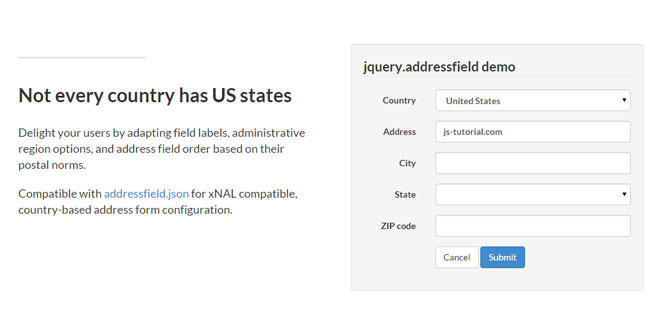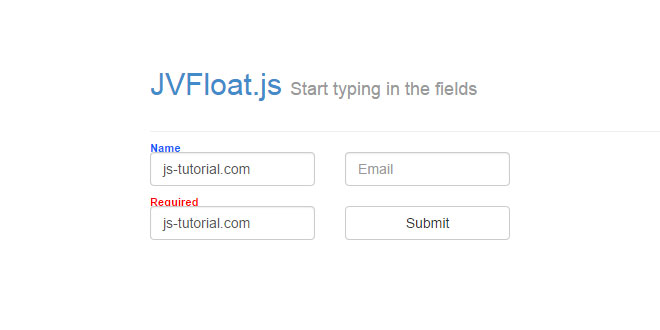1. INCLUDE JS FILES
<script src="/path/to/jquery.js"></script>
<script src="/path/to/jquery.addressfield.js"></script>
2. HTML
<form id="address-form">
<input class="fieldname1" />
<select class="fieldname2 some-other-class">
<option value="AA">AA Value</option>
</select>
</form>
3. JAVASCRIPT
At a high level, all you're doing is calling jQuery.addressfield on a fieldset or other field/form wrapper, with a given configuration mapping and a list of fields you want to be dynamic.
$('#address-form').addressfield(config, dynamicFields);
Where config is an object that fits this format:
{
"_comment" : "Note that field order will be respected.",
"fields" : [{
"fieldname1" : {
"_comment" : "All fields must include labels.",
"label" : "Label for field1"
}
}, {
"fieldname2" : {
"label" : "Label for field2"
"_comment" : "Fields with options will be converted to selects.",
"options" : [{
"AA" : "AA Value"
}, {
"BB" : "BB Value"
}]
}
}]
}
And dynamicFields is just an array of fields you care about.
dynamicFields = ['fieldname1', 'fieldname2', 'fieldname3'];
And the input elements include their respective field names as classes, e.g.
<form id="address-form">
<input class="fieldname1" />
<select class="fieldname2 some-other-class">
<option value="AA">AA Value</option>
</select>
</form>
4. A MORE REALISTIC USAGE EXAMPLE
Here's a sample configuration for Canada, which has a known, distinct list of provinces, and the United Kingdom, which doesn't have a list of administrative regions. Also note the labels for province/county and postal code/postcode.
{
"CA" : {
"fields" : [{
"administrativearea" : {
"label" : "Province",
"options" : [{
"" : "--"
}, {
"AB" : "Alberta"
}, {
"BC" : "British Columbia"
}, {
"MB" : "Manitoba"
}, {
"NB" : "New Brunswick"
}, {
"NL" : "Newfoundland"
}, {
"NT" : "Northwest Territories"
}, {
"NS" : "Nova Scotia"
}, {
"NU" : "Nunavut"
}, {
"ON" : "Ontario"
}, {
"PE" : "Prince Edward Island"
}, {
"QC" : "Quebec"
}, {
"SK" : "Saskatchewan"
}, {
"YT" : "Yukon Territory"
}]
}
}, {
"postalcode" : {
"label" : "Postal code"
}
}]
},
"GB" : {
"fields" : [{
"administrativearea" : {
"label" : "County"
}
}, {
"postalcode" : {
"label" : "Postcode"
}
}]
}
}
And here's some sample markup:
<form class="shipping">
<div class="country-wrapper">
<label for="address-country">Country</label>
<select class="country" id="address-country" name="address[country]">
<option value="CA">Canada</option>
<option value="GB" selected>United Kingdom</option>
</select>
</div>
<div class="thoroughfare-wrapper">
<label for="address-thoroughfare">Address 1</label>
<input class="thoroughfare" type="text" id="address-thoroughfare" name="address[thoroughfare]" value="">
</div>
<div class="premise-wrapper">
<label for="address-premise">Address 2 </label>
<input class="premise" type="text" id="address-premise" name="address[premise]" value="">
</div>
<div class="locality">
<div class="localityname-wrapper">
<label for="address-localityname">City</label>
<input class="localityname" type="text" id="address-localityname" name="address[localityname]" value="">
</div>
<div class="administrativearea-wrapper">
<label for="address-administrativearea">State</label>
<input class="administrativearea" type="text" id="address-administrativearea" name="address[administrativearea]" value="">
</div>
<div class="postalcode-wrapper">
<label for="address-postalcode">ZIP code</label>
<input class="postalcode" type="text" id="address-postalcode" name="address[postalcode]" value="">
</div>
</div>
</form>
You might write some JavaScript like this to make it very simply dynamic:
// Load the JSON asynchronously.
$.getJSON('path/to/above.json', function(config) {
// On country change...
$('.country').bind('change', function () {
// Trigger the addressfield plugin with the country's data.
$('.shipping').addressfield(config[this.value], [
'administrativearea',
'postalcode'
]);
});
});
 JS Tutorial
JS Tutorial




